Landscaping around your home can make it look more attractive, and trees are among the most impressive and useful landscape elements. If you’d like your house to appear wider, plant a tree near its corner, choosing a variety that’s not too tall but has a wide canopy. A dogwood tree can be a good example in this regard, due to its mature height of 15 to 30 feet and a spreading form that can reach 30 feet wide.
Many dogwood shrubs and trees are distinguished by showy flower heads, flowers or bracts. Large or small, the white, yellow, pink or red blossoms always have four petals. The combination of attractive flowers, excellent fall color in many species and varieties, brilliantly colored new growth in some species and showy fall fruits make dogwood species good choices for woodland gardens, habitat gardens and layouts where landscape elements must remain interesting in three or even four seasons.
Dogwood fruits can be red, blue-black, yellow or white at maturity. Most are classified as “drupes,” which means that the actual seed is enclosed in a stony wall, which is in turn enclosed by a fleshy exterior coating. Dogwood fruits are attractive and edible to birds and small animals. Some species’ fruits are bitter-tasting and may cause mild gastric distress in humans.
In nature, dogwood trees grow as understory plants bordering mixed deciduous and evergreen forests, thriving in the protection and partial shade provided by larger trees. In the home garden, dogwood trees flower best when they have sunlight, but not full sun. Dense shade and full sun both hinder flowering.
- Kousa Dogwood (Cornus kousa)
- Cornelian Cherry Dogwood (Cornus mas)
- Red Osier Dogwood (Cornus sericea)
- Silky Dogwood (Cornus amomum)
- Gray Dogwood (Cornus racemosa)
- Pagoda Dogwood (Cornus alternifolia)
- Pacific Dogwood (Cornus nuttallii)
- Creeping Dogwood (Cornus canadensis)
- Common (Cornus sanguinea)
- Siberian Dogwood (Cornus alba)
- Himalayan Flowering dogwood (Cornus capitata)
- Roughleaf Dogwood (Cornus drummondii)
- Swamp Dogwood (Cornus foemina)
- Giant Dogwood (Cornus controversa)
- Large-leaf Dogwood (Cornus macrophylla)
- Walter’s dogwood (Cornus walteri)
- Blackfruit dogwood (Cornus sessilis)
Flowering Dogwood

Flowering dogwood trees usually reach 20 to 30 feet and are often just as wide, making a dramatic specimen for the garden or patio. This deciduous tree is characterized by horizontal branches along most of the trunk, with a rounded or more upright crown. Flowering dogwoods have green leaves with pale undersides from spring through summer.
The green is more yellow than blue giving the tree a warm appearance in the garden. In the fall, flowering dogwoods put on a show of color as the green leaves turn to reds and oranges.The stunning blooms of flowering dogwood are actually bracts that surround its tiny flowers.
Kousa Dogwood

Kousa dogwood (Cornus kousa), also known as Chinese, Japanese or Korean dogwood adorns its surroundings with elegantly star-shaped, cream-colored spring blooms, red summer berries and striking, red-to-purple autumn leaves.As the trees mature, they will take on a more rounded shape with horizontally spreading branches.
At maturity, the kousa dogwood ranges between 15 and 30 feet in height; its spread is typically between 15 and 30 feet as well, but mature trees are often wider than they are tall. In the garden, the tree is striking as a lone specimen or in small groups. Mature trees also have attractive exfoliating bark, and pruning lower branches makes the bark more visible.
Cornelian Cherry Dogwood
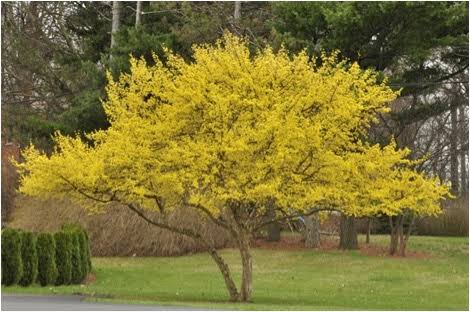
Cornelian cherry dogwood trees reach 20 feet tall and spread 20 feet wide. This plant grows 24 inches tall each summer until mature. Unless trimmed into a tree shape, this dogwood produces multiple stems. The growth is so dense that the shade underneath the tree prevents anything from growing. The shiny, dark green leaves last until the late fall.
The tree produces yellow flowers in spring and cherry-like fruit in the summer, which is used in wine, syrup or jam.This tree makes a good specimen tree or accent tree for the yard. It is well-suited for planting under utility trees because it does not get extremely tall. When planted as a hedge, it produces a non-thorny barrier or windbreak.
Red Osier Dogwood
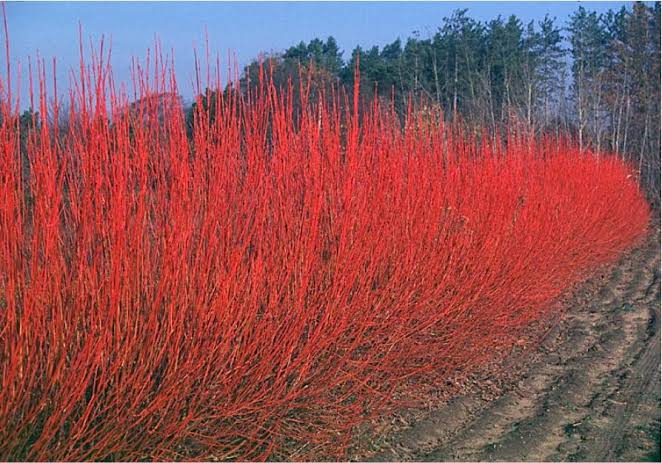
Red osier dogwood is also sometimes known as red-stemmed dogwood or redtwig dogwood is a deciduous shrub that features red and orange autumn foliage, dark red winter shoots, ovate green leaves in spring, white flowers in late spring and early summer, and white berries tinged with blue in summer.
The red osier dogwood grows in a loose branching formation, with upright stems and horizontal branches. It reaches a height and width of 5 to 9 feet. Also, it grows quite rapidly, akin to its cousin the flowering dogwood, which gains a height of 2 feet each growing season. Red Osier brings color and texture to the garden each season, adding curb appeal to your home.
Also Read: Types of Magnolia Trees And Shrubs
Silky Dogwood

Silky dogwood is large to a medium-sized deciduous shrub that may grow 6 to 12 feet tall. The shrub is multi-stemmed, open, and rounded. Clusters of creamy white flowers bloom in the spring followed by blue drupes that ripen late summer. The leaves and twigs have silky hairs. A distinctive feature of this shrub is the dark brown pith of 1 to 2-year-old stems and dark-reddish twigs.
The shrub grows unruly and forms dense thickets when left on its own and really should be used in informal gardens when a manicured look is not needed. The shrub is often used as an effective method to deal with stabilizing slopes and streambank erosion. Combining the silky dogwood with other plants, such as willows, as a canopy alongside grasses at ground level can help manage erosion nicely.
Gray Dogwood
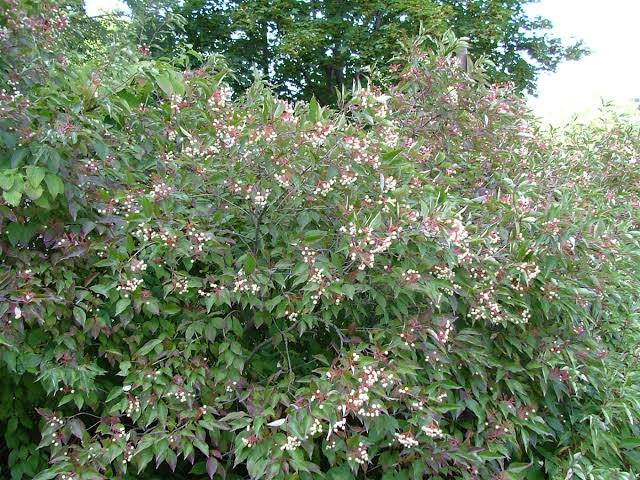
Gray Dogwood is a flowering shrub that reaches a height up to 15 feet tall forming a thicket. Stems are mostly smooth but with some wart-ish bumps, and gray except for the newer twigs which are reddish-brown and have pale lenticular lenticels. Gray Dogwood has clusters of creamy white flowers at the ends of the branches in late spring with grayish green deciduous foliage.
The pointy leaves turn an outstanding deep purple in the fall. It also produces white berries in late summer. Gray dogwoods are great for borders, groups, and masses. They can also be grown as small trees to be used for foundations, entranceways, borders, or specimen planting.Generally, Gray Dogwood can be distinguished from other Dogwood shrubs by its dome-shaped panicles of flowers, which are about as tall as they are wide. Other species in this genus produce flat-topped panicles of flowers that are wider than they are tall.
Pagoda Dogwood
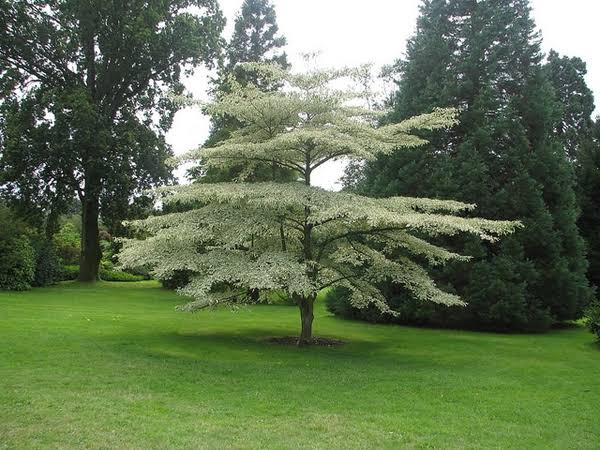
Pagoda dogwood is known for its pagoda-like horizontal branches forming tiers. It is also unique in that its leaves are arranged alternately along the stem, thus its other common name, “alternate-leaf” dogwood. Branches are nearly parallel to the ground, giving the plant an attractive textural effect.
Pagoda dogwood offers extremely fragrant, yellowish white flowers followed by attractive, bluish black fruit. Pagoda Dogwood can be used as a small specimen tree in landscape beds, especially near entries or patios, or as part of a large shrub border. As a native understory plant, this tree is especially appropriate in shady naturalized areas or woodland gardens underneath shade tree canopies.
Also Read: Different Types of Shrubs For Landscaping your garden
Pacific Dogwood
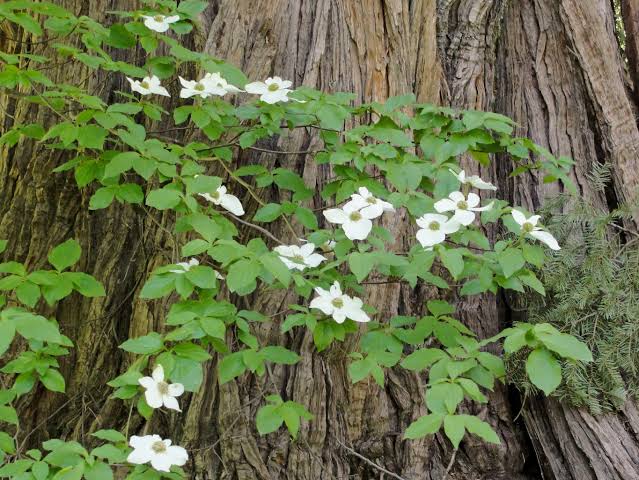
Cornus nuttallii, the Pacific dogwood, western dogwood, or mountain dogwood, is a deciduous tree growing up to 20 meters tall (66 feet) with a smooth dark bark. The deciduous leaves start off dark green and shiny, but turn red or gold in the autumn. Smooth and thin young bark develops thick ridges with maturity, giving the trunk an attractive, textured appearance.
The showy, fragrant flowers of the California dogwood first appear in spring and usually continue blooming into early summer. Each flower features six creamy-white, petal-like bracts surrounding a green center. The flowers give way to clusters of vibrant red, berrylike fruits called drupes, which reach up to 1/2-inch long and add a pop of color to winter landscapes. Pacific Dogwood prefers moist, well-drained sites and is most often found as an understory tree in fairly open, mixed forests.
Eddie’s White Wonder dogwood
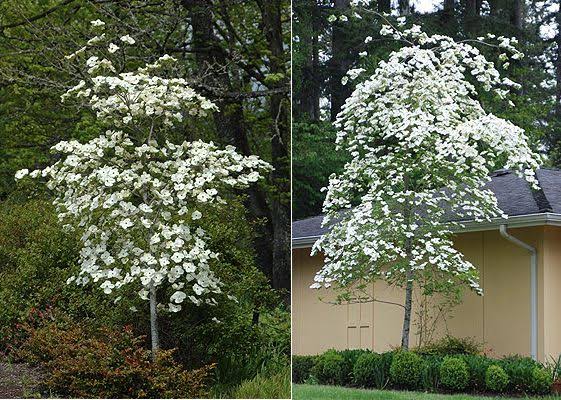
Eddie’s White Wonder dogwood was developed in the1950s as a hybrid between two native species, the Pacific dogwood (Cornus nuttallii) and the common flowering dogwood (Cornus florida), native to Eastern North America. In early spring, the hybrid produces abundant, striking white 4-inch wide flowers with especially large, overlapping false petals, or bracts.
The tree has a more narrow frame than native types, with branches that arise in a layered pattern to give the tree a somewhat pyramidal shape. Eddie’s White Wonder is also taller than other dogwoods, reaching a height of 20 feet at maturity with a width of about 15 feet. In the fall, Cornus Eddie’s White Wonder provides additional landscape interest when its leaves turn an attractive reddish color. After flowering, the tree develops orange to red fruits called drupes, which are about one half inch in diameter with a spiny surface.
Little Poncho Chinese Dogwood
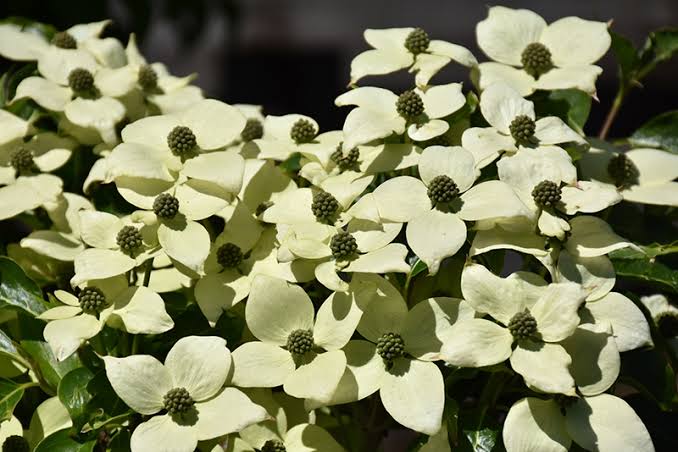
Little Poncho Chinese Dogwood will grow to be about 10 feet tall at maturity, with a spread of 8 feet. It is a multi-stemmed deciduous tree with a stunning habit of growth which features almost oriental horizontally-tiered branches.Little Poncho Chinese Dogwood features showy clusters of creamy white flowers with olive green eyes held atop the branches in early summer.
It features an abundance of magnificent red berries with orange overtones from early to mid fall. It has dark green deciduous foliage. The glossy pointy leaves turn outstanding shades of red and scarlet in the fall. The peeling gray bark adds an interesting dimension to the landscape.Its average texture blends into the landscape, but can be balanced by one or two finer or coarser trees or shrubs for an effective composition.
Also Read: Different Types of Hibiscus Flowers
Creeping Dogwood

Bunchberry is an erect, low-growing plant, three to eight inches tall. It grows from creeping roots and often forms colonies. The leaves are dark green and shiny. They appear to grow in whorls of four to six. Bunchberry plants sport what appears to be a single, showy white flower in late spring and early summer.
The “flower” is actually a series of four large petal-like bracts, surrounding the actual flowers, which are tiny and greenish, with four minute petals. The flower head is usually about an inch wide. This plant is also called Bunchberry Dogwood, Dwarf Dogwood, Canadian Bunchberry, Dogwood Bunchberry, Pudding Berry, Crackerberry, Creeping Dogwood, and Dwarf Cornel.
Siberian Dogwood

The Siberian Dogwood also referred to as the red-barked or white Dogwood is a deciduous flowering shrub that is upright, bushy, multi-stemmed, and twiggy. It may grow up to 8 to 15 feet tall when it matures. This dogwood variety has clusters of creamy white flowers at the ends of the branches in late spring. It has green deciduous foliage.
The pointy leaves turn an outstanding burgundy in the fall. It produces blue berries in mid summer. The coral-pink branches are extremely showy and add significant winter interests.
Common Dogwood
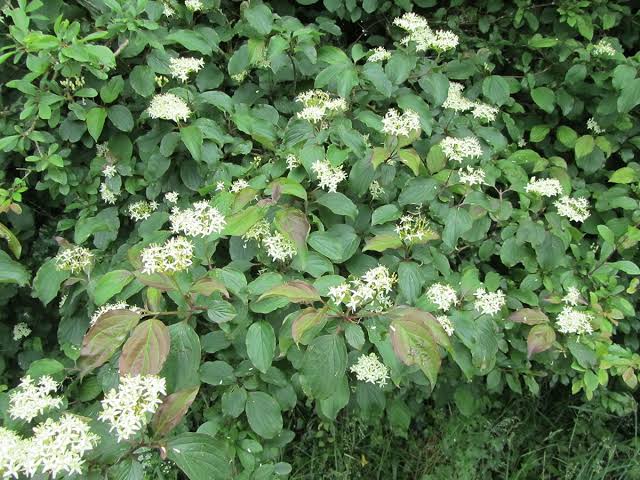
Cornus sanguinea, the common dogwood or bloody dogwood is a medium to large deciduous shrub, growing 7-20 feet tall. The bark is grey and smooth with shallow ridges which develop with age, and its twigs are smooth, straight and slim. Leaf buds are black and look like bristles, forming on short stalks.
There are small bunches of dull white flowers in spring with a strong rather unpleasant smell; these flowers are followed by black berries in mid-summer through fall. The species spreads by seeds and stolons. It is especially abundant in riversides, especially in shady areas and ravines. It grows in the margins of forests or unforested areas as woods in regeneration or prickly woodland fringes.
Himalayan Dogwood
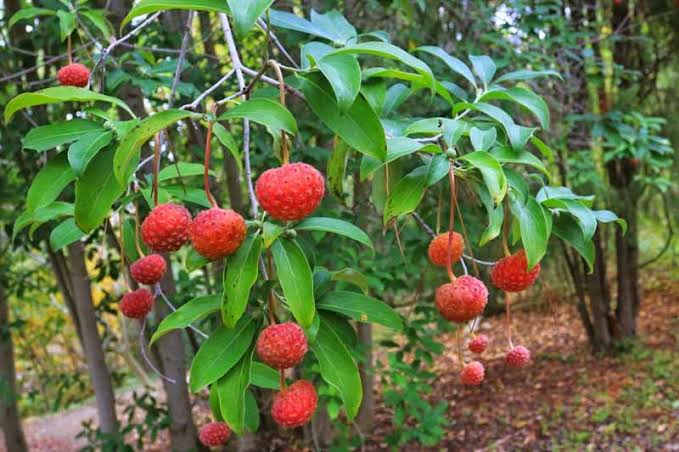
Himalayan flowering dogwood also referred to as Evergreen dogwood or Bentham’s cornel is a fantastic species native to the Himalayas. It is similar to Cornus kousa (Japanese Dogwood) in appearance but grows larger and has evergreen leaves. The flowers generally emerge a cream-yellow and age to white over several weeks during the spring, by late summer the flowers give way to ornamental red fruit about an inch in diameter.
Due to the size and color of the fruit, this species is also commonly known as the Chinese Strawberry Tree. In climates with warm winters the leaves will remain evergreen, in colder climates the leaves will generally drop in early winter. They are used as isolated specimens in medium and small gardens or in bushy groups. They are recommended plants for temperate climates with not very hot summers.
Roughleaf Dogwood
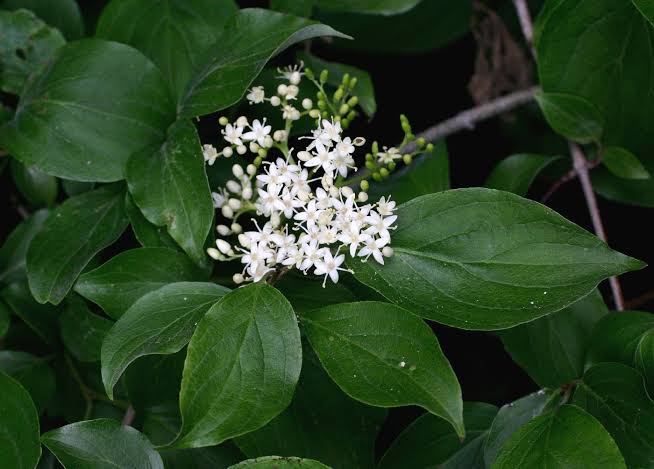
Cornus drummondii, commonly known as the roughleaf dogwood, is a small deciduous tree roughleaf dogwood has shiny green leaves, showy clusters of creamy white flowers from May to August, round white fruit, and red foliage in the fall. It grows in woodlands, edges of thickets and creeksides. Although it is usually multi-trunked, it can be pruned to a tree form, growing as high as 16 feet. A large specimen has a trunk with grey bark.
This bark is covered with rough flattened scales that are taller than wide. The thin grey bark of branches is often covered with scattered small bumps. It grows quickly and suckers profusely, a negative in gardens or near lawns but an asset for erosion control, stabilizing banks, shelter-belt plantings, or planting for wildlife in naturalized or wild areas.
Also Read: Different Types of Black-eyed Susan
Swamp Dogwood
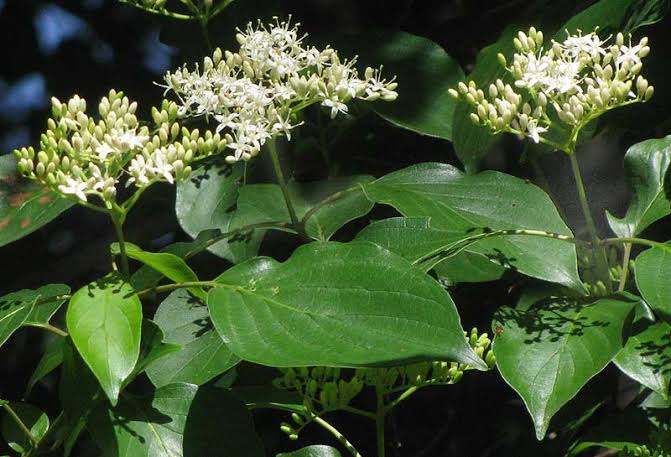
Cornus foemina also known by the common names stiff dogwood and swamp dogwood is a deciduous flowering shrub or small tree with attractive red twigs, clusters of showy white flowers in the spring, and pale blue to blue-violet fruits in the fall. The tree or shrub may grow from 10 to 25 feet tall. The Stiff Dogwood is usually multi-trunked.
The pith of the tree is white. The bark is reddish-brown on young plants and becomes gray and furrowed with age. The upper surface of the leaves is dark green and smooth, and the lower surfaces are pale gray-green with sparse hairs. The flowers are creamy-white and appear on the terminal ends of branches in the spring. The fruit is a blue drupe that is produced in the fall.
Giant Dogwood

Giant Dogwood will grow to be about 50 feet tall at maturity, with a spread of 25 feet.The growth rate is moderate to rapid. Its form is picturesque and wide-spreading.
This plant has horizontal branches that appear to be “layered”. Giant Dogwood features showy clusters of white flowers held atop the branches in mid spring. It has dark green deciduous foliage. The pointy leaves turn an outstanding dark red in the fall. It produces deep purple berries from early to late fall. The warty gray bark and green branches add an interesting dimension to the landscape.
Walter’s Dogwood
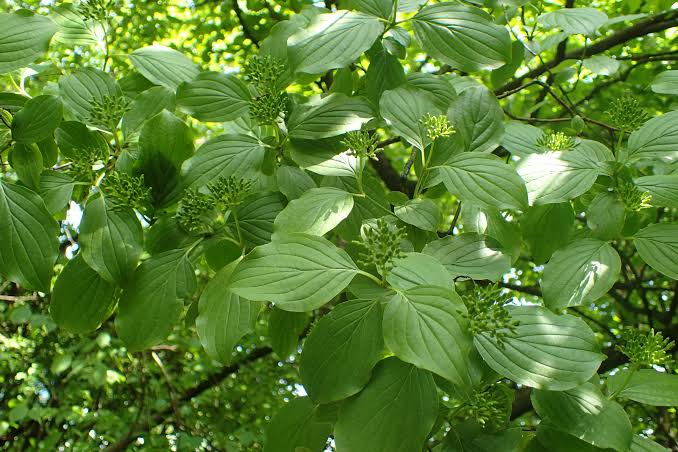
Walter Dogwood is a medium-sized deciduous tree reaching 30 to 40 feet in height and width. The two to five-inch-long leaves are dark green and are joined in June by the small white flowers arranged in two to three-inch diameter cymes. The blossoms are followed by the production of small black fruits which are popular with birds and other wildlife.
Walter Dogwood is probably best known for the alligator-like bark on older specimens, even more so than Flowering Dogwood. Young specimens have an upright branching habit giving way to an open spreading habit. The branches probably droop less than most other Dogwoods, making it a possible candidate for street tree use.
Also Read: Different Varieties of Japanese Maples
Blackfruit Dogwood
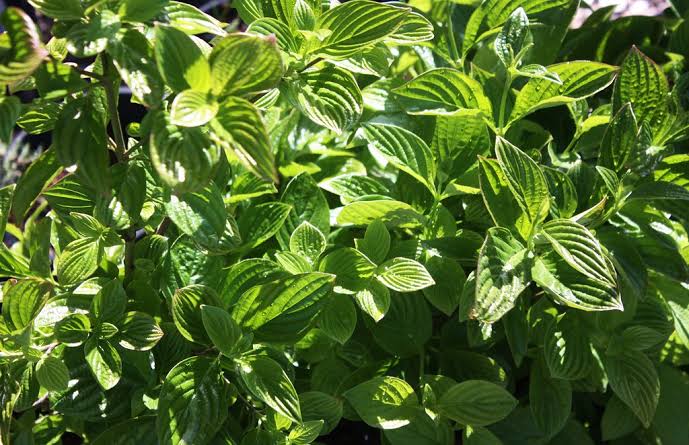
Cornus sessilis is a species of dogwood known by the common names blackfruit cornel, blackfruit dogwood, and miner’s dogwood. This is a shrub or small tree that may reach five meters in height at maximum.
It is deciduous, bearing deeply veined oval green leaves in season which turn red before falling. Its inflorescence is a cluster of tiny greenish-yellow flowers surrounded by thick, pointed bracts. The fruit is a round drupe about a centimeter wide which is white when new and gradually turns shiny black. The fruit attracts many birds.
Silky Dogwood (Cornus amomum)
- Native to eastern North America.
- Blue fruit, reddish-purple fall foliage, and purplish stems.
- Grows 6–12 feet, thrives in wet areas.
Yellow Twig Dogwood (Cornus sericea ‘Flaviramea’)
- A cultivar of C. sericea with vibrant yellow stems.
- White flowers and berries, grows 5–8 feet.
- Stunning in winter landscapes.
Hybrid Dogwood (Cornus × rutgersensis)
- Cross between C. florida and C. kousa (e.g., ‘Stellar’ series).
- Combines disease resistance of Kousa with the beauty of Flowering Dogwood.
- Grows 15–25 feet, with white or pink bracts.
Wedding Cake Tree (Cornus ‘Eddie’s White Wonder’)
- Hybrid of C. florida and C. nuttallii.
- Abundant white bracts and compact growth.
- Grows 15–20 feet, great for small gardens.
Ivory Halo Dogwood (Cornus alba ‘Bailhalo’)
- A compact cultivar of C. alba with variegated green and white leaves.
- Red stems, grows 4–6 feet.
- Ideal for small spaces.
Kelsey’s Dwarf Dogwood (Cornus sericea ‘Kelseyi’)
- A low-growing cultivar with red stems and white flowers.
- Grows 2–3 feet, perfect for borders.
Arctic Fire Dogwood (Cornus sericea ‘Farrow’)
- Compact C. sericea with vivid red winter stems.
- Grows 3–5 feet, cold-hardy and low-maintenance.
Bunchberry (Cornus canadensis)
- A groundcover dogwood native to North America.
- White bracts, red berries, and low growth (4–8 inches).
- Thrives in shady, moist areas.
Creeping Dogwood (Cornus suecica)
- Similar to C. canadensis, native to northern Europe and Asia.
- White flowers and red fruit, grows 4–6 inches.
- Ideal for woodland gardens.
Variegated Stellar Pink Dogwood (Cornus × ‘Rutgan’)
- A hybrid shrub with pink bracts and variegated foliage.
- Grows 10–15 feet, blends tree and shrub qualities.
- Striking in mixed borders.
Midwinter Fire Dogwood (Cornus sanguinea ‘Midwinter Fire’)
- A cultivar with fiery orange-red stems in winter.
- White flowers, grows 5–6 feet.
- Adds bold color to winter gardens.
Conclusion
The beauty of the dogwood lasts for most of the year — from the early spring flowers in pink or white, to the summer greenery to the fall turning of the leaves from green to red, maroon and yellow, to the winter stems all in red. The berries, whether from the kousa or the florida, add to the parade of color produced by the dogwood. The tree, while not demanding too much attention, needs the right footing to be healthy and productive.
Further References
- How To Grow And Care For Dogwood Trees: https://www.gardeningknowhow.com/ornamental/trees/dogwood/caring-dogwood-trees.htm
- Dogwood Trees Facts: https://www.thetreecenter.com/dogwood-tree-facts/
- Everything You Need To Know About Dogwood: https://www.google.com/amp/s/www.thisoldhouse.com/platform/amp/gardening/21333880/white-dogwood-trees?espv=1